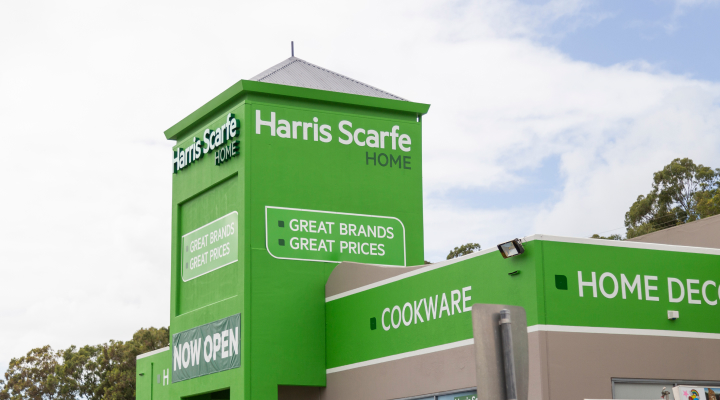Australian discount department store Harris Scarfe is moving “full-steam ahead” with its strategic growth plans, despite rising inflation and growing concerns about an economic recession. “We’re full-steam ahead, we’re not battening down the hatches because inflation is going up. We’re absolutely still expanding the business as per the original strategic plan,” Graham Dean, CEO of Harris Scarfe, which is owned by Spotlight Retail Group, told Inside Retail. T
;
That includes improving its e-commerce offering and expanding its bricks-and-mortar store network, particularly in growth corridors where consumers tend to spend a lot on homewares.
“Obviously, inflationary pressures are a headwind we don’t want, but we just have to face it, and we have to do the best job we can to satisfy the market,” Dean said. “We still remain optimistic that it won’t be as bad as people are saying it will be.”
Location, location, location
Harris Scarfe currently has 52 stores, including 41 full-line stores that sell apparel, manchester, homewares, small electronics and luggage, and 11 Harris Scarfe Home stores that offer homewares exclusively.
The retailer expects to open at least four more stores – two full-line locations and two Home locations – this calendar year, with many more in the pipeline.
Aggressive expansion has been a top priority for the business since it was acquired by Spotlight Retail Group in 2020. Dean believes there’s room for 100 Harris Scarfe stores in Australia; it’s simply a matter of finding the right locations at the right price.
“We have a list of desired locations, and if they become available and we’re able to do a commercial deal, then we’ll be in a position to open them,” he said.
When it comes to the Harris Scarfe Home format, the desired locations are growth corridors with good catchments for home-related products. This generally means close to development land where more housing will be built over time.
They also need to be the right distance from full-line Harris Scarfe stores so that the offerings complement each other without cannibalising sales.
“If you think about Melbourne, we have a Frankston centre with a full-line store, and just down the road in Mornington, we have a 1000sqm Home store in a homemaker centre, which services that whole corridor down to the Mornington Peninsula,” Dean said.
The Mornington Peninsula is a good example of the type of growth corridor that Harris Scarfe is targeting.
A coastal region about an hour outside of Melbourne, it has seen a population boom over the last two years, as people have started to prioritise space and access to nature over proximity to the office.
Housing prices there have gone up nearly 15 per cent in the year to March 2022, according to Domain, as has spending on homewares.
“The Mornington store has performed particularly well,” Dean said.
All about the home
Harris Scarfe Home stores range between 1000sqm and 2200sqm and carry both ‘hard’ and ‘soft’ homewares, meaning tableware and cookware, as well as manchester. This sets the retailer apart from local competitors like Adairs and House, which tend to focus on one or the other.
The format also gives Harris Scarfe the ability to operate in homemaker centres and thus reach customers who are primed to purchase items for their home. It can’t open full-line stores in homemaker centres because they aren’t zoned for apparel retail.
“Our Waurn Ponds store [in Victoria] is opposite a Bunnings, so people might be going there to buy products to renovate their home, but they’ve also got to decorate it. They might be putting in a new kitchen, but they’ve also got to buy the cookware, they’ve got to buy the tableware,” Dean explained.
“It’s a customer who has home in mind already, as opposed to someone going into a shopping centre who might be buying a new pair of jeans, but that doesn’t mean they’re going to buy a saucepan set.”
While he declined to provide specific figures, Dean said the format is driving incremental growth for the business.
“Our recent store opening in Cambridge, Tasmania, set a record for store openings over the last few years, and it’s a relatively small Home store,” he said.
The retailer is still experimenting with different store sizes, layouts and offerings. In April, it opened a 2200sqm Harris Scarfe Home store in West Burleigh, Queensland, that features an extended range not available in full-line stores, and a new layout where products are arranged like they would in a real home.
“Before, all the electrical products would be together, the irons would be next to the toasters, but that’s not how the customer shops,” Dean said. “They shop for a toaster because they’re shopping for their kitchen, they shop for an iron because they’re looking to update their laundry.”
Investing in digital
In addition to its physical retail expansion, Harris Scarfe is also looking to improve its online offering.
Since being acquired by Spotlight Retail Group, it has moved onto a new e-commerce platform that has “a lot more bells and whistles”, and relaunched core aspects of its website, including the user experience, navigation, checkout process and payment options, and invested in conversion rate optimisation.
It has also opened a dark site in Victoria to speed up the fulfilment process for online orders, and launched a click-and-collect offering, which it didn’t have before.
“We’ve been very busy in the digital space, and Covid amplified that,” Dean said.

